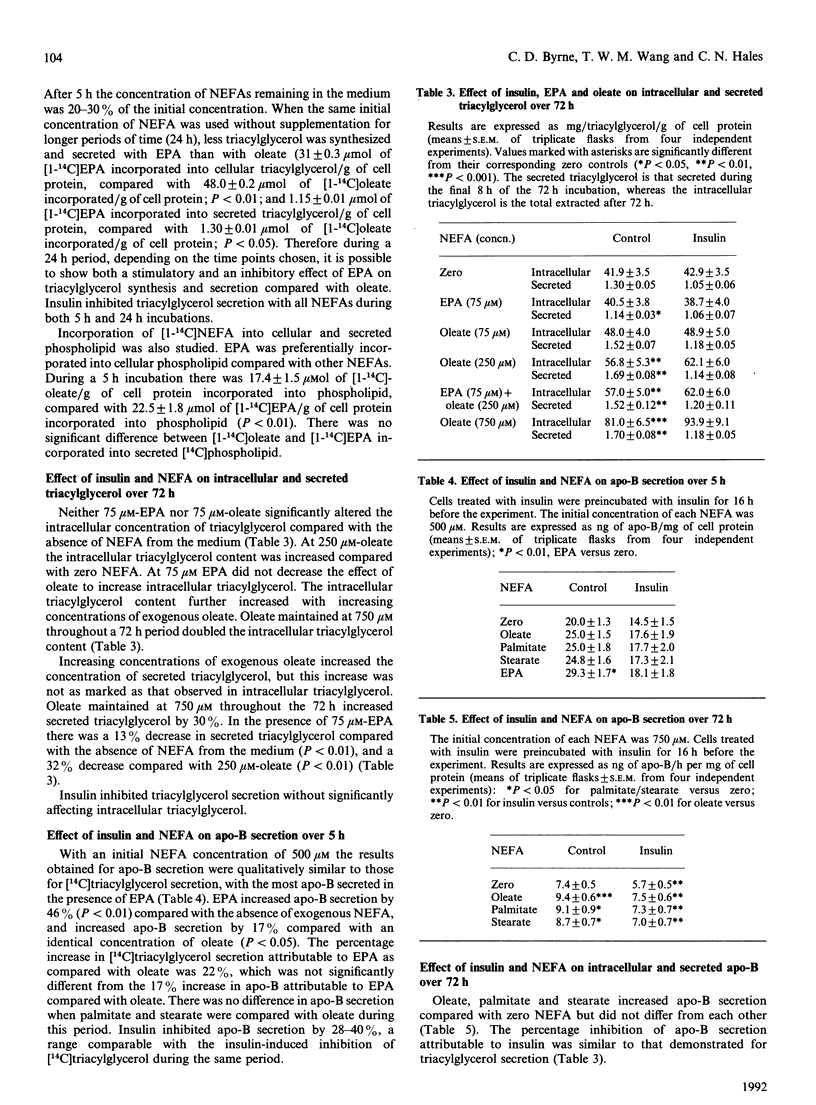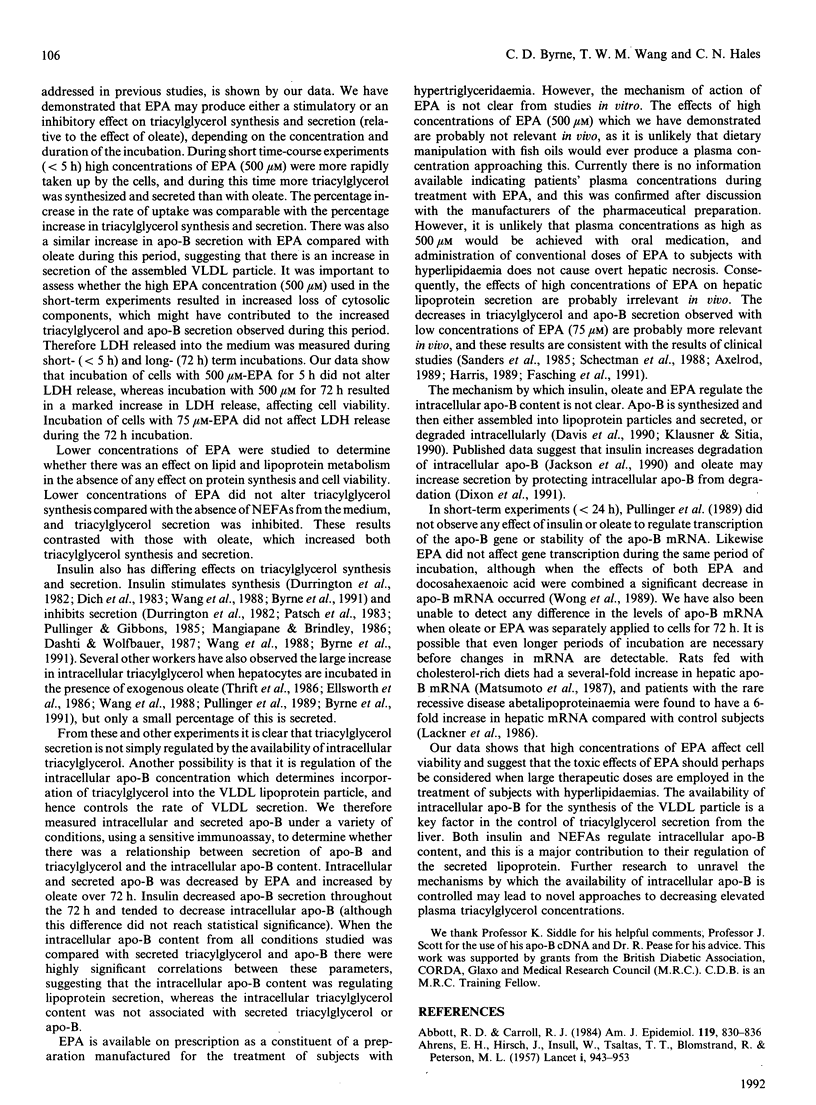Abstract
Non-esterified fatty acids (NEFAs) and insulin are important factors in the control of lipoprotein secretion, but the mechanism of action is unclear. The present study was undertaken to determine whether insulin and NEFAs modulated hepatic secretion of triacylglycerol and apolipoprotein B (apo-B) by regulation of hepatic intracellular apo-B content. The experiments were performed with the human hepatoblastoma cell line Hep G2, for periods of up to 72 h in the presence and absence of NEFAs and insulin. Higher concentrations of eicosapentanoate (EPA) sustained for 72 h decreased cellular protein content (at 250 microM) or caused cell death (at 750 microM), and this effect was not observed with the other NEFAs studied, whereas 75 microM-EPA did not affect cell viability. Compared with the absence of NEFA, 75 microM-EPA did not alter the intracellular triacylglycerol content, but decreased the intracellular content of apo-B by 47% (P < 0.01) and decreased secreted triacylglycerol and secreted apo-B by 13% (P < 0.05) and 21% (P < 0.01) respectively, after 72 h. However 250 microM-oleate increased the intracellular triacylglycerol by 36% (P < 0.01), intracellular apo-B by 22% (P < 0.05) and secreted triacylglycerol and apo-B by 20-30% (P < 0.05-0.01). Insulin decreased secreted triacylglycerol and apo-B in the presence of each NEFA studied by 20-30%. There was no correlation between the changes in intracellular triacylglycerol and the rate of secretion. However, when the secreted triacylglycerol or apo-B was plotted against intracellular apo-B content a significant correlation was observed (r = 0.89, P < 0.001 for both analyses). Apo-B mRNA levels did not change after 72 h incubation with oleate or EPA. These results demonstrate that EPA can be toxic to hepatocytes and that NEFAs and insulin control secretion of triacylglycerol and apo-B by regulation of the intracellular apo-B concentration, thus controlling assembly of apo-B with triacylglycerol to form lipoproteins.
Full text
PDF






Selected References
These references are in PubMed. This may not be the complete list of references from this article.
- AHRENS E. H., Jr, INSULL W., Jr, BLOMSTRAND R., HIRSCH J., TSALTAS T. T., PETERSON M. L. The influence of dietary fats on serum-lipid levels in man. Lancet. 1957 May 11;272(6976):943–953. doi: 10.1016/s0140-6736(57)91280-1. [DOI] [PubMed] [Google Scholar]
- Abbott R. D., Carroll R. J. Interpreting multiple logistic regression coefficients in prospective observational studies. Am J Epidemiol. 1984 May;119(5):830–836. doi: 10.1093/oxfordjournals.aje.a113803. [DOI] [PubMed] [Google Scholar]
- Assmann G., Schulte H. The Prospective Cardiovascular Münster (PROCAM) study: prevalence of hyperlipidemia in persons with hypertension and/or diabetes mellitus and the relationship to coronary heart disease. Am Heart J. 1988 Dec;116(6 Pt 2):1713–1724. doi: 10.1016/0002-8703(88)90220-7. [DOI] [PubMed] [Google Scholar]
- Axelrod L. Omega-3 fatty acids in diabetes mellitus. Gift from the sea? Diabetes. 1989 May;38(5):539–543. [PubMed] [Google Scholar]
- BROCKERHOFF H. BREAKDOWN OF PHOSPHOLIPIDS IN MILD ALKALINE HYDROLYSIS. J Lipid Res. 1963 Jan;4:96–99. [PubMed] [Google Scholar]
- Bang H. O., Dyerberg J., Hjøorne N. The composition of food consumed by Greenland Eskimos. Acta Med Scand. 1976;200(1-2):69–73. doi: 10.1111/j.0954-6820.1976.tb08198.x. [DOI] [PubMed] [Google Scholar]
- Byrne C. D., Brindle N. P., Wang T. W., Hales C. N. Interaction of non-esterified fatty acid and insulin in control of triacylglycerol secretion by Hep G2 cells. Biochem J. 1991 Nov 15;280(Pt 1):99–104. doi: 10.1042/bj2800099. [DOI] [PMC free article] [PubMed] [Google Scholar]
- Cambien F., Jacqueson A., Richard J. L., Warnet J. M., Ducimetiere P., Claude J. R. Is the level of serum triglyceride a significant predictor of coronary death in "normocholesterolemic" subjects? The Paris Prospective Study. Am J Epidemiol. 1986 Oct;124(4):624–632. doi: 10.1093/oxfordjournals.aje.a114435. [DOI] [PubMed] [Google Scholar]
- Chomczynski P., Sacchi N. Single-step method of RNA isolation by acid guanidinium thiocyanate-phenol-chloroform extraction. Anal Biochem. 1987 Apr;162(1):156–159. doi: 10.1006/abio.1987.9999. [DOI] [PubMed] [Google Scholar]
- Dahlén G., Berg K., Gillnäs T., Ericson C. Lp(a) lipoprotein/pre-beta1-lipoprotein in Swedish middle-aged males and in patients with coronary heart disease. Clin Genet. 1975 Apr;7(4):334–341. doi: 10.1111/j.1399-0004.1975.tb00338.x. [DOI] [PubMed] [Google Scholar]
- Dashti N., Wolfbauer G. Secretion of lipids, apolipoproteins, and lipoproteins by human hepatoma cell line, HepG2: effects of oleic acid and insulin. J Lipid Res. 1987 Apr;28(4):423–436. [PubMed] [Google Scholar]
- Davis R. A., Thrift R. N., Wu C. C., Howell K. E. Apolipoprotein B is both integrated into and translocated across the endoplasmic reticulum membrane. Evidence for two functionally distinct pools. J Biol Chem. 1990 Jun 15;265(17):10005–10011. [PubMed] [Google Scholar]
- Dich J., Bro B., Grunnet N., Jensen F., Kondrup J. Accumulation of triacylglycerol in cultured rat hepatocytes is increased by ethanol and by insulin and dexamethasone. Biochem J. 1983 Jun 15;212(3):617–623. doi: 10.1042/bj2120617. [DOI] [PMC free article] [PubMed] [Google Scholar]
- Dixon J. L., Furukawa S., Ginsberg H. N. Oleate stimulates secretion of apolipoprotein B-containing lipoproteins from Hep G2 cells by inhibiting early intracellular degradation of apolipoprotein B. J Biol Chem. 1991 Mar 15;266(8):5080–5086. [PubMed] [Google Scholar]
- Durrington P. N., Newton R. S., Weinstein D. B., Steinberg D. Effects of insulin and glucose on very low density lipoprotein triglyceride secretion by cultured rat hepatocytes. J Clin Invest. 1982 Jul;70(1):63–73. doi: 10.1172/JCI110604. [DOI] [PMC free article] [PubMed] [Google Scholar]
- Dyerberg J., Bang H. O., Hjorne N. Fatty acid composition of the plasma lipids in Greenland Eskimos. Am J Clin Nutr. 1975 Sep;28(9):958–966. doi: 10.1093/ajcn/28.9.958. [DOI] [PubMed] [Google Scholar]
- Ellsworth J. L., Erickson S. K., Cooper A. D. Very low and low density lipoprotein synthesis and secretion by the human hepatoma cell line Hep-G2: effects of free fatty acid. J Lipid Res. 1986 Aug;27(8):858–874. [PubMed] [Google Scholar]
- FOLCH J., LEES M., SLOANE STANLEY G. H. A simple method for the isolation and purification of total lipides from animal tissues. J Biol Chem. 1957 May;226(1):497–509. [PubMed] [Google Scholar]
- Fasching P., Ratheiser K., Waldhäusl W., Rohac M., Osterrode W., Nowotny P., Vierhapper H. Metabolic effects of fish-oil supplementation in patients with impaired glucose tolerance. Diabetes. 1991 May;40(5):583–589. doi: 10.2337/diab.40.5.583. [DOI] [PubMed] [Google Scholar]
- Harris W. S. Fish oils and plasma lipid and lipoprotein metabolism in humans: a critical review. J Lipid Res. 1989 Jun;30(6):785–807. [PubMed] [Google Scholar]
- Hegsted D. M., McGandy R. B., Myers M. L., Stare F. J. Quantitative effects of dietary fat on serum cholesterol in man. Am J Clin Nutr. 1965 Nov;17(5):281–295. doi: 10.1093/ajcn/17.5.281. [DOI] [PubMed] [Google Scholar]
- Herrmann W., Biermann J., Lindhofer H. G., Kostner G. Beeinflussung des atherogenen Risikofaktors Lp(a) durch supplementäre Fischölaufnahme bei Patienten mit moderatem physischem Training. Med Klin (Munich) 1989 Sep 15;84(9):429–433. [PubMed] [Google Scholar]
- Homan R., Grossman J. E., Pownall H. J. Differential effects of eicosapentaenoic acid and oleic acid on lipid synthesis and secretion by HepG2 cells. J Lipid Res. 1991 Feb;32(2):231–241. [PubMed] [Google Scholar]
- Howard B. V. Lipoprotein metabolism in diabetes mellitus. J Lipid Res. 1987 Jun;28(6):613–628. [PubMed] [Google Scholar]
- Jackson T. K., Salhanick A. I., Elovson J., Deichman M. L., Amatruda J. M. Insulin regulates apolipoprotein B turnover and phosphorylation in rat hepatocytes. J Clin Invest. 1990 Nov;86(5):1746–1751. doi: 10.1172/JCI114900. [DOI] [PMC free article] [PubMed] [Google Scholar]
- Kannel W. B., McGee D. L. Diabetes and cardiovascular disease. The Framingham study. JAMA. 1979 May 11;241(19):2035–2038. doi: 10.1001/jama.241.19.2035. [DOI] [PubMed] [Google Scholar]
- Klausner R. D., Sitia R. Protein degradation in the endoplasmic reticulum. Cell. 1990 Aug 24;62(4):611–614. doi: 10.1016/0092-8674(90)90104-m. [DOI] [PubMed] [Google Scholar]
- Kostner G. M., Avogaro P., Cazzolato G., Marth E., Bittolo-Bon G., Qunici G. B. Lipoprotein Lp(a) and the risk for myocardial infarction. Atherosclerosis. 1981 Jan-Feb;38(1-2):51–61. doi: 10.1016/0021-9150(81)90103-9. [DOI] [PubMed] [Google Scholar]
- LOWRY O. H., ROSEBROUGH N. J., FARR A. L., RANDALL R. J. Protein measurement with the Folin phenol reagent. J Biol Chem. 1951 Nov;193(1):265–275. [PubMed] [Google Scholar]
- Lackner K. J., Monge J. C., Gregg R. E., Hoeg J. M., Triche T. J., Law S. W., Brewer H. B., Jr Analysis of the apolipoprotein B gene and messenger ribonucleic acid in abetalipoproteinemia. J Clin Invest. 1986 Dec;78(6):1707–1712. doi: 10.1172/JCI112766. [DOI] [PMC free article] [PubMed] [Google Scholar]
- Lang C. A., Davis R. A. Fish oil fatty acids impair VLDL assembly and/or secretion by cultured rat hepatocytes. J Lipid Res. 1990 Nov;31(11):2079–2086. [PubMed] [Google Scholar]
- Mangiapane E. H., Brindley D. N. Effects of dexamethasone and insulin on the synthesis of triacylglycerols and phosphatidylcholine and the secretion of very-low-density lipoproteins and lysophosphatidylcholine by monolayer cultures of rat hepatocytes. Biochem J. 1986 Jan 1;233(1):151–160. doi: 10.1042/bj2330151. [DOI] [PMC free article] [PubMed] [Google Scholar]
- Matsumoto A., Aburatani H., Shibasaki Y., Kodama T., Takaku F., Itakura H. Cloning and regulation of rat apolipoprotein B mRNA. Biochem Biophys Res Commun. 1987 Jan 15;142(1):92–99. doi: 10.1016/0006-291x(87)90455-4. [DOI] [PubMed] [Google Scholar]
- Nossen J. O., Rustan A. C., Gloppestad S. H., Målbakken S., Drevon C. A. Eicosapentaenoic acid inhibits synthesis and secretion of triacylglycerols by cultured rat hepatocytes. Biochim Biophys Acta. 1986 Oct 24;879(1):56–65. doi: 10.1016/0005-2760(86)90266-3. [DOI] [PubMed] [Google Scholar]
- Patsch W., Franz S., Schonfeld G. Role of insulin in lipoprotein secretion by cultured rat hepatocytes. J Clin Invest. 1983 May;71(5):1161–1174. doi: 10.1172/JCI110865. [DOI] [PMC free article] [PubMed] [Google Scholar]
- Pullinger C. R., Gibbons G. F. Effects of hormones and pyruvate on the rates of secretion of very-low-density lipoprotein triacylglycerol and cholesterol by rat hepatocytes. Biochim Biophys Acta. 1985 Jan 9;833(1):44–51. doi: 10.1016/0005-2760(85)90251-6. [DOI] [PubMed] [Google Scholar]
- Pullinger C. R., North J. D., Teng B. B., Rifici V. A., Ronhild de Brito A. E., Scott J. The apolipoprotein B gene is constitutively expressed in HepG2 cells: regulation of secretion by oleic acid, albumin, and insulin, and measurement of the mRNA half-life. J Lipid Res. 1989 Jul;30(7):1065–1077. [PubMed] [Google Scholar]
- Reaven G. M., Chen Y. D. Role of insulin in regulation of lipoprotein metabolism in diabetes. Diabetes Metab Rev. 1988 Nov;4(7):639–652. doi: 10.1002/dmr.5610040703. [DOI] [PubMed] [Google Scholar]
- Rhoads G. G., Dahlen G., Berg K., Morton N. E., Dannenberg A. L. Lp(a) lipoprotein as a risk factor for myocardial infarction. JAMA. 1986 Nov 14;256(18):2540–2544. [PubMed] [Google Scholar]
- Sanders T. A., Sullivan D. R., Reeve J., Thompson G. R. Triglyceride-lowering effect of marine polyunsaturates in patients with hypertriglyceridemia. Arteriosclerosis. 1985 Sep-Oct;5(5):459–465. doi: 10.1161/01.atv.5.5.459. [DOI] [PubMed] [Google Scholar]
- Schectman G., Kaul S., Kissebah A. H. Effect of fish oil concentrate on lipoprotein composition in NIDDM. Diabetes. 1988 Nov;37(11):1567–1573. doi: 10.2337/diab.37.11.1567. [DOI] [PubMed] [Google Scholar]
- Thrift R. N., Forte T. M., Cahoon B. E., Shore V. G. Characterization of lipoproteins produced by the human liver cell line, Hep G2, under defined conditions. J Lipid Res. 1986 Mar;27(3):236–250. [PubMed] [Google Scholar]
- Uusitupa M., Siitonen O., Pyörälä K., Aro A., Hersio K., Penttilä I., Voutilainen E. The relationship of cardiovascular risk factors to the prevalence of coronary heart disease in newly diagnosed type 2 (non-insulin-dependent) diabetes. Diabetologia. 1985 Sep;28(9):653–659. doi: 10.1007/BF00291970. [DOI] [PubMed] [Google Scholar]
- WROBLEWSKI F., LADUE J. S. Lactic dehydrogenase activity in blood. Proc Soc Exp Biol Med. 1955 Oct;90(1):210–213. doi: 10.3181/00379727-90-21985. [DOI] [PubMed] [Google Scholar]
- Wang S. R., Pessah M., Infante J., Catala D., Salvat C., Infante R. Lipid and lipoprotein metabolism in Hep G2 cells. Biochim Biophys Acta. 1988 Aug 12;961(3):351–363. doi: 10.1016/0005-2760(88)90082-3. [DOI] [PubMed] [Google Scholar]
- Wong S. H., Fisher E. A., Marsh J. B. Effects of eicosapentaenoic and docosahexaenoic acids on apoprotein B mRNA and secretion of very low density lipoprotein in HepG2 cells. Arteriosclerosis. 1989 Nov-Dec;9(6):836–841. doi: 10.1161/01.atv.9.6.836. [DOI] [PubMed] [Google Scholar]
- Wong S. H., Marsh J. B. Inhibition of apolipoprotein secretion and phosphatidate phosphohydrolase activity by eicosapentaenoic and docosahexaenoic acids in the perfused rat liver. Metabolism. 1988 Dec;37(12):1177–1181. doi: 10.1016/0026-0495(88)90197-7. [DOI] [PubMed] [Google Scholar]
- Wong S., Reardon M., Nestel P. Reduced triglyceride formation from long-chain polyenoic fatty acids in rat hepatocytes. Metabolism. 1985 Oct;34(10):900–905. doi: 10.1016/0026-0495(85)90135-0. [DOI] [PubMed] [Google Scholar]


